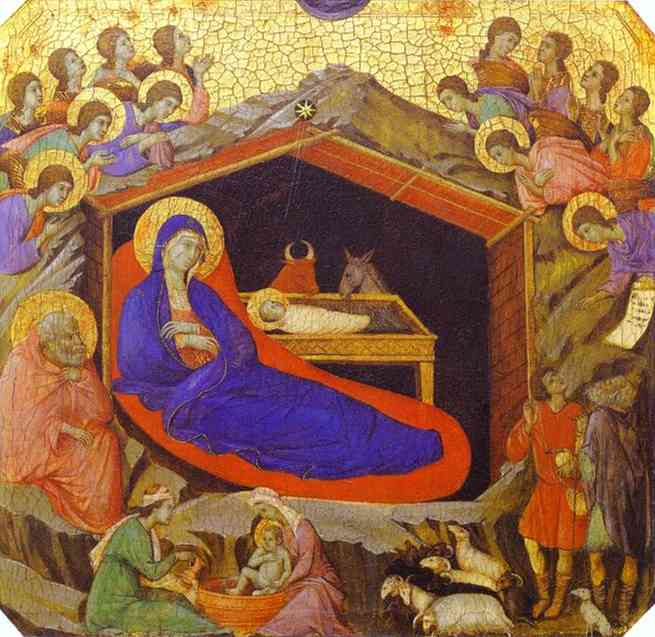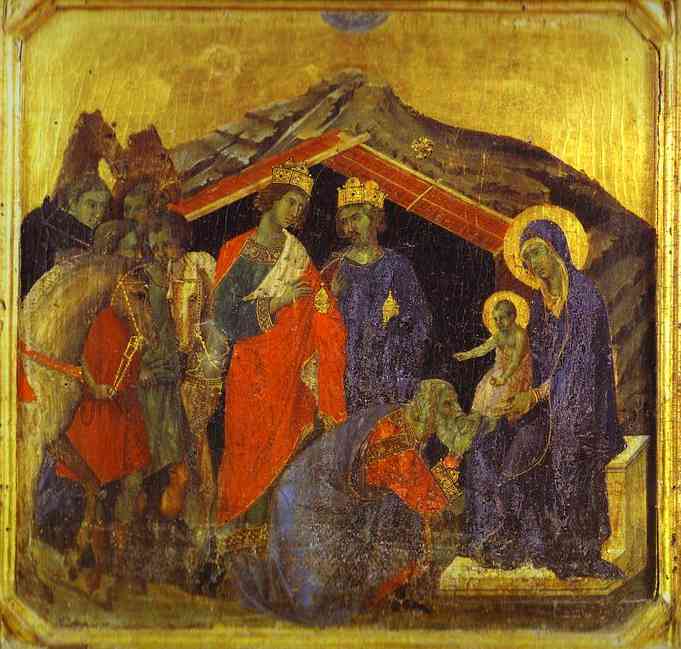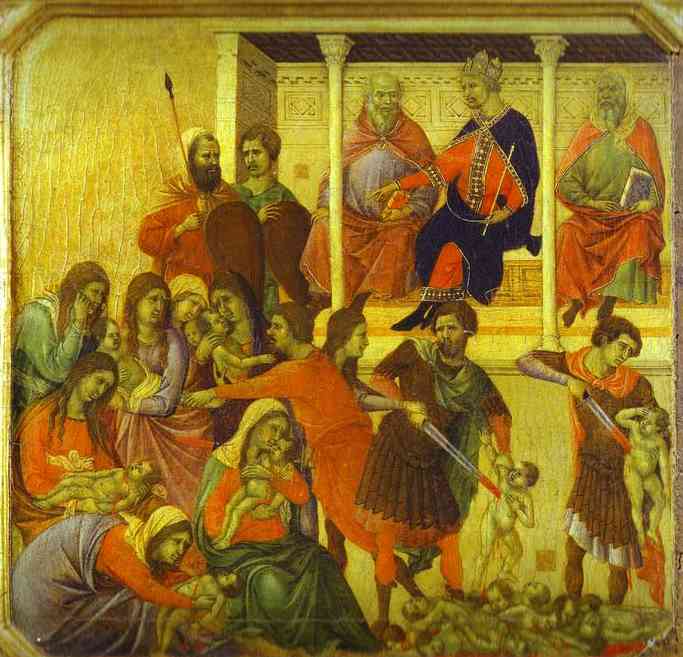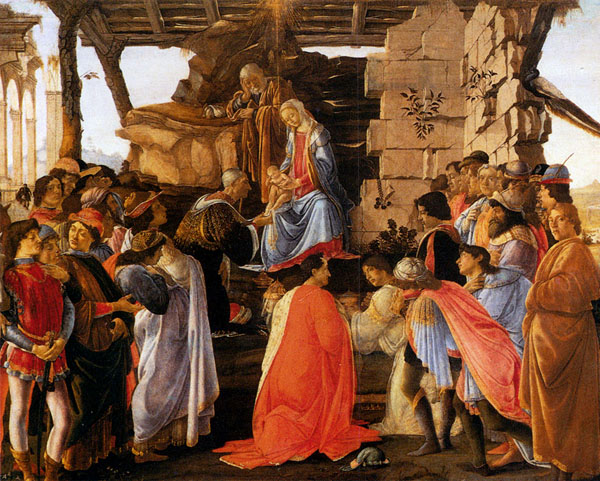Christmas (mass of Christ) is the annual Christian holiday commemorating the birth of Jesus. The actual date of the birth of Jesus is unknown, but it is known that Christmas was celebrated on December 25, as early as 336 A.D. That year Emperor Constantine, who had converted to Christianism, introduced the holiday of Christmas, probably in an effort to draw the attention away from pagan rites that were celebrated around the same time. He cleverly turned one of them, ”Natalis Sol Invicti,” the rebirth of the Sun into Christmas. III-V century Christian scholars report that Christ was called the Sun of Righteousness, which makes celebrating his birthday on the day that the light of the sun returns all the more appropriate. The tradition of Christmas is directly based on the New Testament and has survived the ages largely unchanged. The charming and moving story of the birth of Jesus is very powerful and has inspired many artists to produce great works of art.
The Feast of Nativity, as Christmas was called by early Roman Catholics, was based on the story of Jesus' birth as described by Luke (2:1 - 20) and Matthew (2-2:12) in the New Testament. Jesus was undoubtedly a historical figure, but neither evangelist - Luke nor Matthew - provides historical details of his life or information regarding the date of his birth. Both evangelists centered on the Jesus' nature, his divinity and his humanity. Thus, the New Testament does not help us assess when Jesus was born. However, theological texts of Saint Cyprian (D. 258 A.D.) and Saint John Chrysostom the Doctor of the Church(347 - 407 A.D.) from III - V century provide facts, which allow for a fairly good determination of the date when Jesus was born.
”But Our Lord, too, is born in the month of December . . . the eight before the calends of January (25 December]). . ., But they call it the ” Birthday of the Unconquered” . Who indeed is so unconquered as Our Lord . . .? Or, if they say that it is the birthday of the Sun, He is the Sun of Justice.”
Although December 25 mentioned by Saint John Chrysostom as a day Jesus' birth is merely traditional and cannot be recognized as the actual date of his birth, it is not difficult to note that the feast of Birthday of the Unconquered, celebrated on 25 December could take a strong claim on the responsibility f or our December date. The history of the solar cult and its position in the Roman Empire which has reached its climax of popularity under Aurelian in 274 A.D. could also support the theory. The Roman celebration Natalis Sol Invicti included masquerades in the streets, magnificent festive banquets, the visiting of friends and the exchange of good-luck gifts known as Strenae or ”lucky fruits.” However the early Church wanted to maintain the birthday of the Christ Child as a solemn and religious holiday in 137 A.D. the Bishop of Rome assented that joy, cheer, merriment and garlands of flowers adorned with lightened candles would be more appropriate to honor the birth of Christ. In 350 A.D., Pope Julius I declared December 25 as the official date to celebrate birth of Jesus.
The New Testament provide us a beautiful lyric, sometimes dramatic description of of the events that accompanied the Jesus' birth. The tales of two evangelists, Matthew and Luke are largely independent of one another and apart from a few common features they offer different, occasionally conflicting pictures especially if it refer to the birth of Jesus.
Matthew (2-1:18) starts his story: ”Now when Jesus was born in the Beth-lehem of Judea in the days of Herod the King, behold, there came wise man from the east to Jerusalem. Asking:. Where is he that is born King of the Jews? for we have seen his star in the east and are come to worship him.” Herod informed wise men that the predicted birthplace of the King of the Jews was Bethlehem and asked them to inform him in the way back home what they have learned about the child. Then the evangelist continues: ”And when they were come into the house, they saw they young child with Mary his mother, and fell down, and worshipped him: and when they had opened their treasures, they presented unto him gifts: gold, and frankincense, and myrrh.” In the dream the visitors were instructed by the angel of the Lord to return home without visiting Herod. The narrative went further describing that Herod intended to eliminate the royal pretender Jesus by killing all the children in Bethlehem two years old and under, and how Joseph with the help of another angel sent to him by God escaped the massacre of the children in Bethlehem. Matthew ends his story with a high drama: ”There was a voice heard, lamentation, and weeping, and great mourning, Rachel weeping for her children, and would not be comforted, because they are not.”
Luke's narrative gives us slightly different, more detailed description of the birth of baby in
Bethlehem. In his narrative Luke is silent on the meeting of the Magi with Herod,
the massacre of the infants in Bethlehem and escape to Egypt described by Matthew. His lyric,
gentle version of the Nativity contains no dramatic events. Yet Luke have had his information
from the Virgin Mary herself. Here is his story (Luke 2:1-20):
Joseph went to Bethlehem, the city of David, with Mary, his espoused wife,
being with child. In Bethlehem, the evangelist continues, ”Mary give birth to her first born son,
and wrapped him in swaddling clothes, and laid him in a manger; because there was
no room for them in the inn. In the same country there were shepherds abiding in the field,
keeping watch over their flock by night. Then the angel of the Lord come upon them ... and said
”I bring you good tidings of great joy which shall be to all people.
For unto you is born this day and the city of David a Saviour, which is Christ the Lord.”
The shepherds said one to another ”Let us now go to Bethlehem,
and see this thing which has taken place ... so they went with haste, and found Mary,
and Joseph, and the child lying in a manger. ”
At the time of the birth of Jesus Judea was ruled by Herod the Great (37 - 4 B.C.), Roman Empire was ruled by Cesar Augustus (27 B.C. - 14 A.D.), t he governor of Syria and first procurator of Judea in that time was Cyrenius. This period of the Jewish history is very well reported by the Jewish historian Flavius Josephus. Analysis of both narratives provided by Matthew and Luke and lecture of ”The Jewish Antiquities” and ”The Jewish War” by Flavius Josephus make it clear that we certainly can interpolate Jesus' birth on December 25 somewhere between 8 B.C. and 4 B.C.
The Roman Catholics first celebrated Christmas, then known as the ”Feast of Nativity,” as early as 336 A.D. Netherless, it was many years before December 25 become universal. Even now some Eastern churches keep the old Christmas on January 6, the Fist of Epiphany.
Depiction of the birth of Jesus provided by Luke and Matthew is one of the most popular theme in European painting. These images become central to Christmas celebrations of the time. The Adoration of the Magi, described by Matthew, which is specifically associated with Epiphany, celebrated on January 6, was therefore originally a more popular subject for representation of the Christmas in the East Churches, whereas The Adoration of the Shepherds based on the lyrical, picturesque narrative given us by Luke, became a central theme for the Roman Catholic church.
Since Luke's narrative of the Nativity (Luke 2:1-7) is immediately followed by the Annunciation to the Shepherds (Luke 2:8-10), naturally the two scenes were amalgamated by the painters of all artistic periods mostly into a background scene with the angel appearing to the Shepherds or as three Shepherds (alluding to three Magi) arriving to adore the Holy Child. Popular, but less popular than Adoration of three Magi (Mat 2: 11), Annunciation (Luke 2:8-10) or Adoration of the Shepherds (Luke 2:16-18) themes in European painting related to Jesus birth are dramas of the Massacre of Innocents (Mat 2:16-18)and Fly into Egypt (Mat 2-13).
In the Middle Ages and Gothic paintings the scenes from the birth of Jesus as described by
Matthew and Luke were often recreated on the great canvases of religious art and altarpieces,
both as main theme of the altar or as scenes in predella.
The narrative was often enriched with descriptive details taken from the apocryphal Infancy
Gospels like a subsidiary scenes of the midwives washing the new-born child, or the figure of
Joseph, crouching on the ground with his head supported on his hand, a motive which itself
became extremely popular in the later centuries.
By ignoring time and space the episodes which occurred at different times and places
were bringing together within one painting. Thus on one painting we can see not only the
actual Nativity but also the scenes prior or after to Jesus' birth. Repeatedly the Nativity
scene was performed in a cave rather than a stable. That was probably influenced
by Byzantine prototypes.
The greatest example of the nativity scenes influenced by Byzantine prototypes is Maesta, the free standing altar for the Cathedral in Siena, by Duccio di Buoninsegna from 1308-11.
 There the narrative is enriched with descriptive details, combining facts taken from Matthew,
Luke and from the apocryphal gospel by James. In the front predella of the Maesta
altar the sweet and serene scene of ”The Nativity” (Luke 2:7-8) shows two midwives
(probably Salome and Zelomi) who are bathing new born Christ while Joseph is
portrayed in his usual thoughtful pose standing outside the grotto and looking sorrowfully
at the baby laying in the manger in swaddling clothes. Mary is shown in the usual
Byzantine manner. To underscore the importance of the Virgin Byzantine painters
used to portrait her larger than the figures around her. The choir of angels, the sweet-smiling
spirits, are singing the song of Glory. The music they produces were so sweet that no voices
or instruments can be compare with it. The words written on the scroll in the angel's hand
are unfortunately illegible. It might have borne the words of angel to the shepherds (Luke 2:11)
”For unto you is born this day and the city of David a Savior, which is Christ the Lord.”
or to indicate that with a birth of the
Savior they have a joyful message to proclaim.
There the narrative is enriched with descriptive details, combining facts taken from Matthew,
Luke and from the apocryphal gospel by James. In the front predella of the Maesta
altar the sweet and serene scene of ”The Nativity” (Luke 2:7-8) shows two midwives
(probably Salome and Zelomi) who are bathing new born Christ while Joseph is
portrayed in his usual thoughtful pose standing outside the grotto and looking sorrowfully
at the baby laying in the manger in swaddling clothes. Mary is shown in the usual
Byzantine manner. To underscore the importance of the Virgin Byzantine painters
used to portrait her larger than the figures around her. The choir of angels, the sweet-smiling
spirits, are singing the song of Glory. The music they produces were so sweet that no voices
or instruments can be compare with it. The words written on the scroll in the angel's hand
are unfortunately illegible. It might have borne the words of angel to the shepherds (Luke 2:11)
”For unto you is born this day and the city of David a Savior, which is Christ the Lord.”
or to indicate that with a birth of the
Savior they have a joyful message to proclaim.
 The scene ”The Adoration of the Magi” from the same front predella of the altar
shows three wise men or magi who appears to have been astronomers. They took a star in
the heavens as a sign that new King of the Jews had been born (Mat 2:9). They followed
the star until it stopped over the place where the child was. About 200 A.D. three magi becomes
the Fathers of the Church called Kings but in
the history of art it became common not earlier than in the 6th century.
The scene ”The Adoration of the Magi” from the same front predella of the altar
shows three wise men or magi who appears to have been astronomers. They took a star in
the heavens as a sign that new King of the Jews had been born (Mat 2:9). They followed
the star until it stopped over the place where the child was. About 200 A.D. three magi becomes
the Fathers of the Church called Kings but in
the history of art it became common not earlier than in the 6th century.
On the thirteenth day after Christ birth (this is the meaning of the word epiphany)
to the three wise men from the east came to worship him. In Duccio painting the golden rays
of the star are shining above the grotto where the baby Jesus lies in Mary's lap (Mat 2:11). The King,
holding his crown on his arm, is banding to kiss the feet of the child. The other two and their
followers are waiting to pay homage to him. To remind the eastern origins of the magi, portrayed
by Duccio as three Kings,
one can notice two camels stand outside the grotto.
 The drama reached its zenith in the third scene of the Duccio's altar ”
Slaughter of the Innocents”
(Mat 2:13-18), which also portrays prior episode where Herod is ordering the slaughter.
The scene is fully explained in the scroll carried by the prophet Jeremiah, where one can read: ”
Vox in Rama audita est, ploratus et ululatus multus: Rachel plorans filios suos.”
(A cry is heard in Rama, a groaning and bitter lamentation: Rachel is weeping for her sons.)
The despair of the weeping mothers the two
soldiers continue the destruction unmoved.
The drama reached its zenith in the third scene of the Duccio's altar ”
Slaughter of the Innocents”
(Mat 2:13-18), which also portrays prior episode where Herod is ordering the slaughter.
The scene is fully explained in the scroll carried by the prophet Jeremiah, where one can read: ”
Vox in Rama audita est, ploratus et ululatus multus: Rachel plorans filios suos.”
(A cry is heard in Rama, a groaning and bitter lamentation: Rachel is weeping for her sons.)
The despair of the weeping mothers the two
soldiers continue the destruction unmoved.
Renaissance painters transformed the sacred atmosphere of the Nativity scenes into totally human and poetic one with deep psychological insight. The idea of placing the holy scene in the single totally realisting setting emphasize the idea of truly realistic event. An intimate everyday reality is underlined by the presence of persons and objects connected to daily activities. The charm, graceful elegance and gentle features of beautiful, young Madonnas gives the scenes natural sweetness, tenderness and spirituality. Truly devoted figure of Joseph gives the scenes lovely, cozy atmosphere common in domestic intimacy, symbolic yet realistic. The sweetness of the naked baby Christ lying in the manger full of hay, or on the bundle of wheat (alluding to the Eucharistic) on the ground was common to many other works of this period. The stable is often depicted as a cave, or symbolically shown as a part of ruined building, or even ruined palace with still standing marble column.
The lively colours and tones stress the lighting of the objects and figures depicted, emphasizing their three-dimensionality. The sculptural quality of the figures are created by masterful use of chiaro-scuro techniques. The using of perspective enlarges and widens the space making it penetrate deeper into the splendid open landscape of the background.
 To enriched the composition Renaissance painters introduced the portraits of the
actual rulers in the Nativity scenes especially in ”The Adoration of the Magi”
(that, in many cases, combine both the Nativity and Adoration scenes). Originally magi,
form 10th century Kings represented the three races, Melchior was an African, a Nubian,
and therefore black, Balthazar was an Asian, and Gasper European. But in art a
good deal of freedom occurred. Rather than showing the magi Renaissance painters
opted for frontal view of the important figures grouped around the Holy Family. It reflects
the destinies and dependent relations of Renaissance people where the men of ruling families
were pleased to shown themselves in the lavish costumes, richly embroidered with pearls and
jewels, as the Kings, paying homage to the Holy Child. Sometimes instead of being depicted as the
Kings, they preferred to be shown as the witness of the nativity events. Renaissance citizens were
pleased to see in a pious scene
distinctive characteristics of the familiar faces.
To enriched the composition Renaissance painters introduced the portraits of the
actual rulers in the Nativity scenes especially in ”The Adoration of the Magi”
(that, in many cases, combine both the Nativity and Adoration scenes). Originally magi,
form 10th century Kings represented the three races, Melchior was an African, a Nubian,
and therefore black, Balthazar was an Asian, and Gasper European. But in art a
good deal of freedom occurred. Rather than showing the magi Renaissance painters
opted for frontal view of the important figures grouped around the Holy Family. It reflects
the destinies and dependent relations of Renaissance people where the men of ruling families
were pleased to shown themselves in the lavish costumes, richly embroidered with pearls and
jewels, as the Kings, paying homage to the Holy Child. Sometimes instead of being depicted as the
Kings, they preferred to be shown as the witness of the nativity events. Renaissance citizens were
pleased to see in a pious scene
distinctive characteristics of the familiar faces.
The altarpiece commissioned to Sandro Botticelli in 1469 by the Florentine businessman, Guasparre del Lama for his burial chapel in the Santa Maria Novella church in Florence depicts The adoration of the Magi. This very theatrical scene of shows us the highest establishment of the Florentine society. The gray haired man in the middle of the group on the right side of the picture whose forefinger pointed to his breast is the commissioner himself. The eldest of the three Kings, Casper, is bending to kiss the saviour's foot. His attribute is standing near him. This role was casted by Cosimo the Medici, the ruler of the Florence. He is seen in the center of the stage, richly dressed in the cloak embroidered in gold and adorned with splendid pearls. To obey the republican conventions, as well as two other Kings he is not wearing a crown. Behind him is standing his grandson Lorenzo the Medici called il Magnifico, who will be a ruler of the Florence 30 years later. On his right side two other Kings, Melchior in Balthazar are preparing to pay the homage to the Holy Child. These roles were casted by Giovanni the Medici and Piero the Medici, Cosimo's two sons. The figure at the far right is Sandro Botticelli himself, the painter. He depicted himself as the spectator of the event, but he is not watching it. His gaze is cool and skeptical. The Adoration of the Magi made Botticelli so famous, both in Florence and Rome, that Pope Sixtus IV appointed him as a leading painter of the Sixtine Chapel.